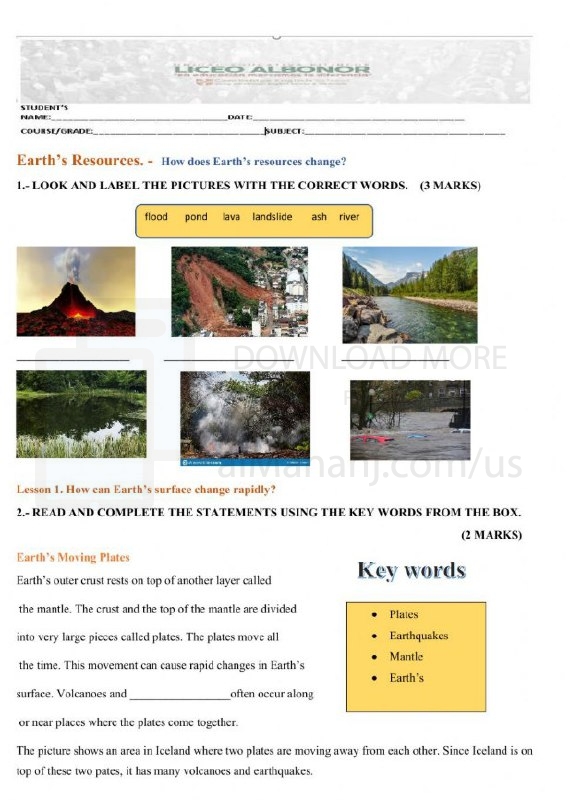| You are here: Almanahj Website ⇒ American curriculum ⇒ 6th Grade ⇒ Geology ⇒ Term 1 | ||
|---|---|---|
Worksheet about Earths Resources | ||
|---|---|---|
| Subject: Geology | ||
| 6th Grade | ||
| Term 1 | ||
| Year: 2023/2024 | ||
| Size: 320.6KB | ||
| Number of clicks: 119 | ||
| Publish date:November 29, 2023 | ||
| Added by: Eman | ||
| Last download date: 2024-09-07 03:50:52 | By: theodor VELEZ2021 | |
| File info: Earth's resources refer to the various materials and substances found on or within the Earth that are valuable and useful to humans. These resources can be classified into several categories based on their origin, availability, and utility. Here are some of the major types of Earth's resources: 1. Renewable Resources: Renewable resources are those that can be replenished naturally or through human intervention within a relatively short time frame. Examples include: - Forest resources: Trees and other vegetation that provide timber, wood products, and ecosystem services like carbon sequestration. - Water resources: Surface water (rivers, lakes) and groundwater that are used for drinking, irrigation, and hydropower. - Solar energy: The Sun's radiation that can be harnessed through solar panels to generate electricity and heat. 2. Non-Renewable Resources: Non-renewable resources are finite and cannot be replenished within a human time scale. Once these resources are depleted, they are no longer available. Examples include: - Fossil fuels: Coal, oil, and natural gas formed over millions of years from organic matter. They are used for energy production, transportation, and manufacturing. - Minerals: Metallic minerals (iron, copper, gold) and non-metallic minerals (salt, gypsum, limestone) used in construction, industry, and manufacturing. - Fossil groundwater: Ancient water stored in underground aquifers that is not recharged at a significant rate. 3. Energy Resources: Energy resources refer to the sources of energy used for various purposes. In addition to fossil fuels and solar energy mentioned earlier, other energy resources include: - Nuclear energy: Energy generated through nuclear fission or fusion processes. - Wind energy: Conversion of wind motion into electricity using wind turbines. - Hydroelectric power: Generation of electricity using the kinetic energy of flowing or falling water. 4. Biological Resources: Biological resources encompass the living organisms and their byproducts that are utilized by humans. Examples include: - Agricultural resources: Crops, livestock, and fisheries that provide food and fiber. - Medicinal plants: Plants and their extracts used in traditional medicine and pharmaceuticals. - Genetic resources: The genetic material of plants, animals, and microorganisms that can be used for breeding, research, and biotechnology. 5. Water Resources: Water resources include all forms of water on Earth, including freshwater bodies, groundwater, and glaciers. These resources are essential for drinking, irrigation, industry, and ecosystem health. 6. Air and Atmospheric Resources: The atmosphere provides vital resources such as oxygen for respiration, carbon dioxide for plant photosynthesis, and protection from harmful solar radiation. Sustainable management and responsible use of Earth's resources are crucial for ensuring their availability for future generations. Conservation practices, efficient resource utilization, and the development of alternative and renewable sources of energy are important steps towards achieving sustainable resource management. | ||
| Downloading link Worksheet about Earths Resources |
|---|
|
1701247864.pdf
The file is being prepared for download
|
| File images |
|---|
 |